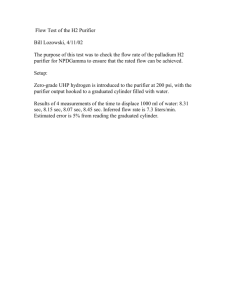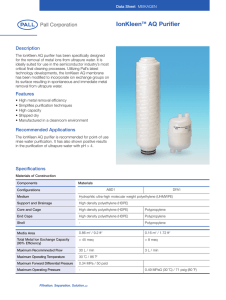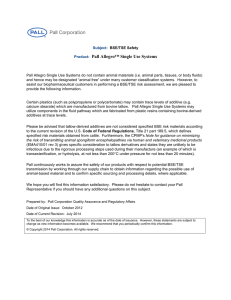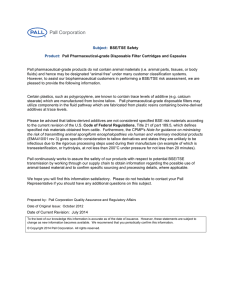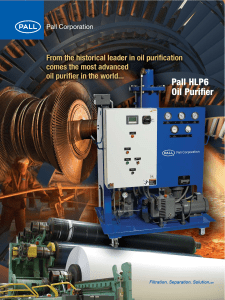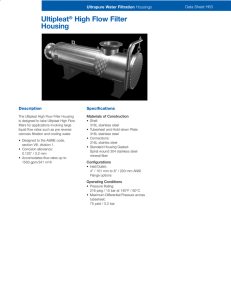The ability of a point-of-use (POU) purifier
advertisement
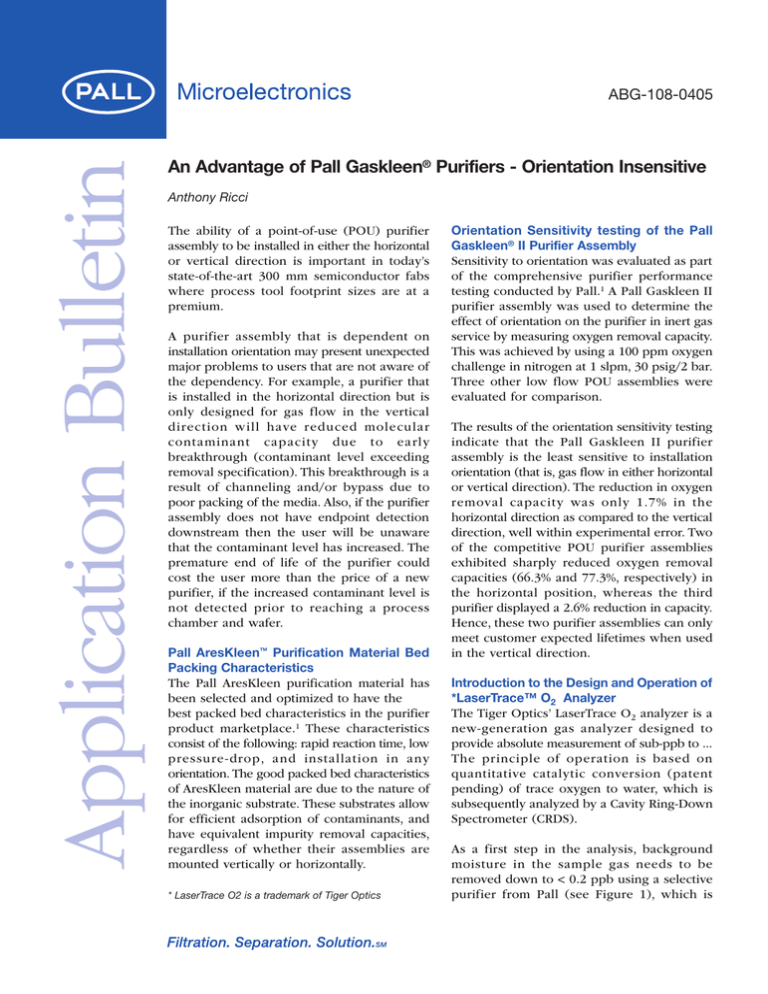
Application Bulletin ABG-108-0405 An Advantage of Pall Gaskleen® Purifiers - Orientation Insensitive Anthony Ricci The ability of a point-of-use (POU) purifier assembly to be installed in either the horizontal or vertical direction is important in today’s state-of-the-art 300 mm semiconductor fabs where process tool footprint sizes are at a premium. A purifier assembly that is dependent on installation orientation may present unexpected major problems to users that are not aware of the dependency. For example, a purifier that is installed in the horizontal direction but is only designed for gas flow in the vertical direction will have reduced molecular contaminant capacity due to early breakthrough (contaminant level exceeding removal specification). This breakthrough is a result of channeling and/or bypass due to poor packing of the media. Also, if the purifier assembly does not have endpoint detection downstream then the user will be unaware that the contaminant level has increased. The premature end of life of the purifier could cost the user more than the price of a new purifier, if the increased contaminant level is not detected prior to reaching a process chamber and wafer. Pall AresKleen™ Purification Material Bed Packing Characteristics The Pall AresKleen purification material has been selected and optimized to have the best packed bed characteristics in the purifier product marketplace.1 These characteristics consist of the following: rapid reaction time, low pressure-drop, and installation in any orientation. The good packed bed characteristics of AresKleen material are due to the nature of the inorganic substrate. These substrates allow for efficient adsorption of contaminants, and have equivalent impurity removal capacities, regardless of whether their assemblies are mounted vertically or horizontally. * LaserTrace O2 is a trademark of Tiger Optics Orientation Sensitivity testing of the Pall Gaskleen® II Purifier Assembly Sensitivity to orientation was evaluated as part of the comprehensive purifier performance testing conducted by Pall.1 A Pall Gaskleen II purifier assembly was used to determine the effect of orientation on the purifier in inert gas service by measuring oxygen removal capacity. This was achieved by using a 100 ppm oxygen challenge in nitrogen at 1 slpm, 30 psig/2 bar. Three other low flow POU assemblies were evaluated for comparison. The results of the orientation sensitivity testing indicate that the Pall Gaskleen II purifier assembly is the least sensitive to installation orientation (that is, gas flow in either horizontal or vertical direction). The reduction in oxygen removal capacity was only 1.7% in the horizontal direction as compared to the vertical direction, well within experimental error. Two of the competitive POU purifier assemblies exhibited sharply reduced oxygen removal capacities (66.3% and 77.3%, respectively) in the horizontal position, whereas the third purifier displayed a 2.6% reduction in capacity. Hence, these two purifier assemblies can only meet customer expected lifetimes when used in the vertical direction. Introduction to the Design and Operation of *LaserTrace™ O2 Analyzer The Tiger Optics’ LaserTrace O2 analyzer is a new-generation gas analyzer designed to provide absolute measurement of sub-ppb to ... The principle of operation is based on quantitative catalytic conversion (patent pending) of trace oxygen to water, which is subsequently analyzed by a Cavity Ring-Down Spectrometer (CRDS). As a first step in the analysis, background moisture in the sample gas needs to be removed down to < 0.2 ppb using a selective purifier from Pall (see Figure 1), which is Analyzer Sample Inlet Pall Rxtor CRDS Cavity To Vent Pall 10 sccm H2 Supply Figure 1. Simplified flow schematics of the Tiger Optics LaserTrace O2 Analyzer (note that not all flow components are illustrated). designed not to interact with the oxygen molecules to be detected. Downstream from the selective purifier, a very small flow of pure hydrogen gas for the conversion process, ~10 sccm, is mixed into the main sample flow of roughly 800 sccm – 1000 sccm. This small stream of hydrogen is purified with a different type of purifier from Pall, which removes moisture, oxygen, carbon dioxide, and carbon monoxide background from the H2 supply. Since the H2 constitutes only ~1% of the total flow, any impact on the measurement accuracy by the dilution of sample gas is considered negligible. Both purifiers are installed in the horizontal orientation. Since each O2 molecule is converted into two H2O molecules, the analyzer’s targeted LDL and sensitivity are in the order of 100 ppt, which would be consistent with the 200 ppt LDL for Tiger Optics’ moisture products based on CRDS. Accomplishing this goal, however, requires a correspondingly challenging impurity removal capability from the purifiers. Additionally, the selective purifier for the sample gas should not in any way alter the 600 500 487 ppb / 502 ppb = 97% 400 300 200 100 0 9:00 9:30 10:00 10:31 11:01 11:31 12:02 12:32 Time (hh:mm) Figure 2. Beta testing of LaserTrace O2 analyzer against a calibration standard (0.502 ppm O2 /N2) at a customer site. 2 13:03 13:33 concentration or interfere with the passage of oxygen content in the sample. Our test data, as illustrated below, show that the performances of both purifiers are satisfactory in meeting all these requirements. Beta Testing of LaserTrace O2 Analyzer at Scott Specialty Gases A LaserTrace O2 analyzer unit was taken to a customer site (Scott Specialty Gases Technology Center (Plumsteadville, PA)) for beta testing. Within ~15 minutes after installation and start up of house nitrogen flow, the instrument was already reading steadily ~1.5 ppb, a level consistent with estimates given by Scott technical staff for trace O2 in their house N2. Figure 2 shows the measurement of LaserTrace O2 analyzer against a 0.502 ppm O2 /N2 blend standard prepared by Scott Exploratory Products Lab. The LaserTrace O2 analyzer readings agreed with the blend standard to within 3%. Following the oxygen analysis, further tests were conducted using a LaserTrace H2O analyzer. In conclusion, a purifier assembly that is dependent on gas flow orientation may present major problems including process gas line contamination and increased purification costs. The Pall AresKleen purification material has been optimized to offer good packed bed characteristics. Comprehensive testing of POU purifier assemblies including orientation sensitivity testing has shown that the Pall Gaskleen II purifier assembly is the least 2200 Northern Boulevard East Hills, New York 11548-1289 USA 1.800.360.7255 toll free (Only in US) 1.516.484.5400 phone 1.516.625.3610 fax sensitive to orientation in the removal of oxygen contamination from inert gas. It can be concluded from the Scott Specialty Gases test results that the sample gas purifier can selectively remove moisture to below 100 ppt without in any way affecting oxygen concentration. The H 2 line purifier, which removes oxygen, water, carbon dioxide, and carbon monoxide from the 99.999% H2, also works extremely well even at this unusually small flow of 10 sccm, considering the overall 0.1 ppb baseline achieved for the whole instrument. Obviously, the fact that both purifiers were installed horizontally does not seem to have compromised their performance at all. References: 1. R. Chakraborty, K. Brown, and M. Horikoshi, “Comprehensive Performance Testing and Characterization of Various Point-Of-Use (POU) Inert Gas Purification Technologies Used in Microelectronics Fabrication Processes,” Gases and Technology; September 2004. Gas Filtration Purifiers Data Sheet A88 Gaskleen® II Purifier Acknowledgements: We would like to thank Dr. Kenneth Wong and other technical staff at Scott Specialty Gases for their kind assistance during the beta testing of the LaserTrace O2 analyzer at their facility. For further information please contact your local Pall sales representative or Pall Applications Group at 800 360 7255. Visit us on the Web at www.pall.com Pall Corporation has offices and plants throughout the world in locations including: Argentina, Australia, Austria, Belgium, Brazil, Canada, China, France, Germany, Hong Kong, India, Indonesia, Ireland, Italy, Japan, Korea, Malaysia, Mexico, the Netherlands, New Zealand, Norway, Poland, Puerto Rico, Russia, Singapore, South Africa, Spain, Sweden, Switzerland, Taiwan, Thailand, United Kingdom, United States, and Venezuela. Distributors are located in all major industrial areas of the world. © Copyright 2005, Pall Corporation. Pall, trademark registered in the USA. ABG-108-0405 , are trademarks of Pall Corporation. ® Indicates a Pall is a service mark of Pall Corporation.
